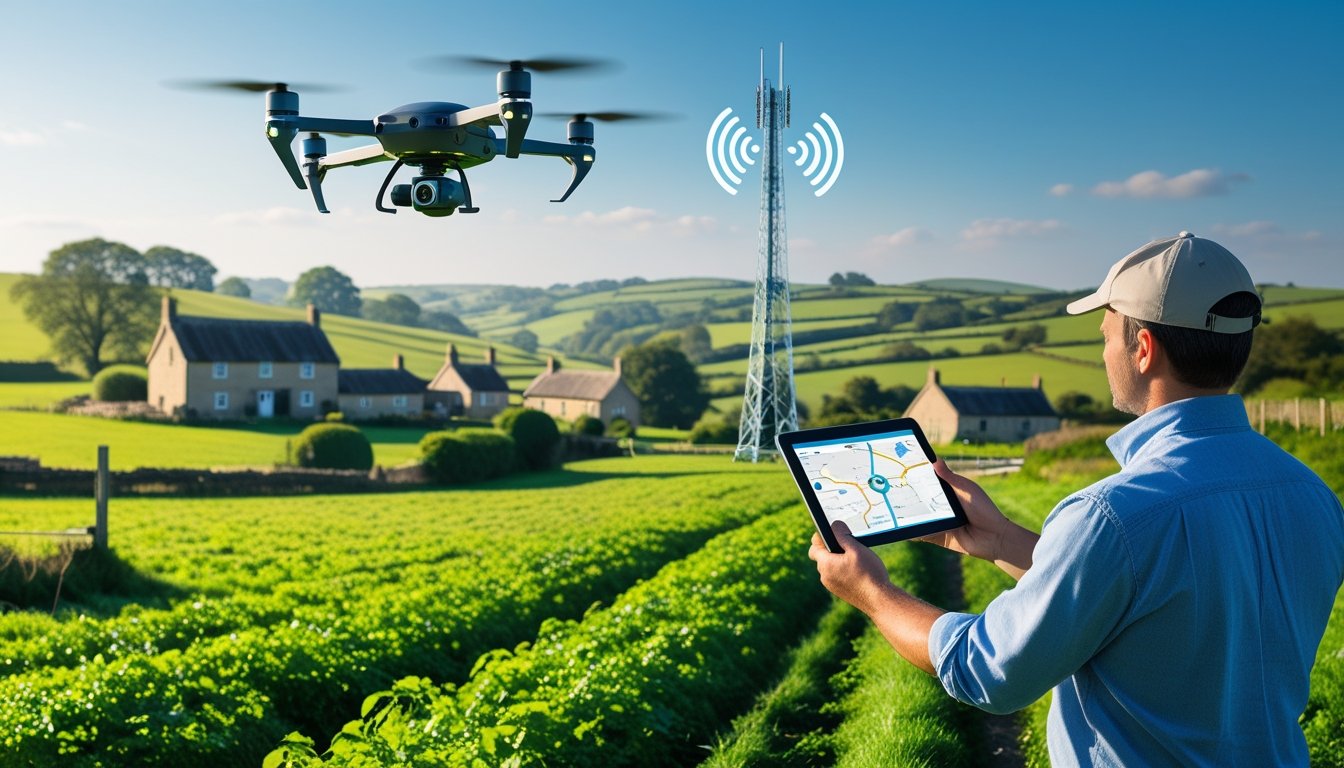Late updated: 27 Jun 2025 10:06
Written by: Oliver Bennett
AI Strategies For Enhancing UK Rural Connectivity: Bridging the Digital Divide
Artificial intelligence is rapidly reshaping rural connectivity in the UK, offering new lifelines to communities long isolated by inadequate digital infrastructure. AI-driven strategies are effectively bridging the gap between urban and rural areas, enhancing broadband accessibility and supporting cutting-edge technology deployments. These advancements not only connect residents to wider networks but also significantly enrich rural living standards by providing access to essential services such as healthcare and education.

The impact of AI on rural connectivity extends beyond basic internet access. By enabling intelligent communications, AI integrates space, air, and ground networks that enhance connectivity. In doing so, it opens up economic opportunities and supports sustainable development goals. This transformation fosters inclusive growth, ensuring that rural communities can thrive alongside urban counterparts.
As we explore the innovative methods employed across the UK, we’ll highlight how AI adapts to meet the unique needs of rural areas. Its potential to transform sectors like telehealth and education is immense, promising a more connected and prosperous future for the countryside.
Key Takeaways
- AI is revolutionising UK rural connectivity with advanced digital strategies.
- Enhanced connectivity opens up new economic and educational opportunities.
- AI integrates diverse networks to meet rural community needs effectively.
AI-Powered Strategies for Transforming UK Rural Connectivity

AI technologies are revolutionising rural connectivity in the UK, providing efficient and strategic solutions that enhance access and sustainability. Intelligent systems optimise network infrastructure and bridge the digital divide, ensuring even the most remote communities benefit from these advancements.
Deploying AI for Enhanced Broadband Accessibility
AI plays a pivotal role in improving broadband accessibility in rural regions. By evaluating data, AI systems identify gaps in existing broadband provision, allowing us to target underserved areas effectively. We deploy machine learning algorithms to predict demand patterns, optimising network usage and ensuring stable connections.
With gigabit-capable broadband efforts like the UK Government's Project Gigabit, AI-driven strategies can accelerate deployment. This involves collaboration with service providers to implement AI-integrated solutions that enhance connection quality and cover geographical challenges.
AI also aids in wireless network development, including 5G connectivity and satellite technology, ensuring high-speed services reach remote areas. Together, these efforts bolster the shared rural network, increasing overall coverage and providing sustainable digital connectivity.
AI-Driven Solutions for Closing the Digital Divide
The digital divide in rural areas is a significant hurdle. AI-driven solutions are essential to address this challenge, promoting digital inclusivity and enabling access to digital services. We focus on AI applications that support public services like education, healthcare, and agriculture, ensuring these essential services are accessible online.
Through AI-powered analytics, we can customise solutions for different rural communities, fostering community engagement. Partnerships with local authorities and stakeholders ensure these technologies meet the unique needs of each area, promoting long-term sustainability.
AI technologies are also employed to develop digital infrastructure that supports community-wide internet access. By fostering strategic planning, we can ensure digital transformations contribute to improved quality of life in rural areas, creating equitable access to digital opportunities.
Leveraging Machine Learning for Predictive Network Infrastructure Planning
Predictive planning is crucial for future-proofing rural connectivity. Machine learning enables us to analyse vast datasets and develop models that forecast network demands and infrastructure needs. These insights guide investment and deployment decisions, ensuring resources are used efficiently.
We harness AI technologies to perform infrastructure assessments, identifying potential weaknesses or areas for improvement. This data-driven approach ensures broadband networks can handle future increases in usage without compromising service quality.
Strategic deployment of smart technologies such as IoT devices supports resource management and optimises network operations. The integration of AI and machine learning in planning processes leads to resilient and sustainable rural connectivity solutions.
Facilitating Sustainable Development with Smart Technologies
Sustainability is central to enhancing rural digital connectivity. Smart technology deployment supports energy management and resource management, minimising environmental impacts while improving efficiency. We employ AI systems to monitor and manage energy use in digital infrastructure, promoting environmental stewardship.
AI supports sustainable development by integrating renewable energy sources and enhancing the resilience of connectivity systems. These innovations provide reliable services, even during adverse conditions, ensuring communities continue to function seamlessly.
Collaborative efforts with UK government initiatives and stakeholders facilitate the scalable implementation of AI-driven improvements. By prioritising sustainability and technological advancements, rural areas can reap the extensive benefits of modern connectivity without jeopardising environmental health.
Impact of AI on Key Sectors and Economic Opportunities in Rural UK

We aim to examine how AI technology is reshaping key sectors within rural UK communities, unleashing new economic opportunities. By focusing on agriculture, healthcare, education, and economic growth, we highlight AI's transformative potential in improving efficiencies, services, and the overall quality of life for these communities.
Boosting Agricultural Productivity with AI and Precision Farming
AI continues to revolutionise agriculture, particularly through precision and smart farming techniques. In rural UK regions, farmers harness AI to analyse data collected from drones and environmental monitoring systems. This enables precise control over resources such as water and fertilisers, reducing waste.
By increasing productivity and efficiency, AI supports sustainable agriculture, reducing costs and environmental impact. Smart tractors and AI-driven tools allow for customised management of crops, enhancing output and quality. The integration of AI in agriculture ensures that rural communities can maintain competitive edge, contributing significantly to local and national economic growth.
Advancing Healthcare Delivery through Telehealth and Remote Monitoring
Rural healthcare has seen substantial improvements with AI's integration into telehealth and remote monitoring services. Telehealth platforms bridge the gap between urban and rural healthcare access, facilitating remote consultations and diagnostics. This improves time efficiency, reduces travel, and offers greater patient engagement.
AI technologies also provide predictive insights into patient health, allowing for proactive management of chronic conditions. In rural UK areas, where specialist services are limited, these advancements ensure timely medical interventions and enhance healthcare delivery. Our commitment to improving rural healthcare through AI platforms is pivotal to elevating the quality of life and health outcomes.
Driving Education and Digital Literacy via AI-Powered Learning
The role of AI in education is reshaping rural education landscapes by promoting digital literacy and customised learning experiences. AI-powered education tools provide tailored content and interactive learning platforms that engage students in rural settings. Remote tutoring offers equal access to quality education resources, regardless of location, fostering an inclusive learning environment.
For educators, AI enhances teaching effectiveness through data-driven insights and personalisation opportunities for learners. By equipping students with digital skills, we contribute to future-proofing their prospects in the evolving digital economy, thus bridging educational divides.
Fostering Rural Economic Growth through AI-Driven Initiatives
AI is a critical driver of economic rejuvenation in rural UK, empowering local economies through diverse initiatives. Leveraging AI for smart transportation, connectivity support through Project Gigabit, and tourism promotion contributes to economic resilience and job creation. Local authorities and service providers collaborate on deploying AI solutions that cater to community development.
By embedding AI across different sectors, including rural tourism and smart agriculture, we facilitate economic development and enhance productivity. The collective progress brought by AI ensures that rural regions remain vibrant and competitive within the broader UK economy, fostering sustained growth and enhanced living standards.
Frequently Asked Questions
Addressing UK rural connectivity involves a deep understanding of challenges, innovative AI applications, and strategic policy development. We explore key aspects like infrastructure enhancement and cost considerations.
What are the primary challenges in deploying AI to improve internet connectivity in rural UK areas?
Rural UK areas face issues such as sparse populations and varied terrains that complicate AI deployment. Infrastructure limitations and funding gaps further hinder progress.
How can artificial intelligence contribute to the development of rural broadband infrastructure across the United Kingdom?
AI tools streamline network management and optimise resource allocations. They enable predictive maintenance, enhancing broadband infrastructure's reliability and efficiency in rural locales.
What successful examples exist of AI applications enhancing rural network connectivity?
Projects like the Rural Connectivity Accelerator demonstrate AI's capability to bolster network performance and accessibility, reducing the urban-rural digital divide.
In what ways can machine learning algorithms support the prediction and management of network loads in the UK's countryside?
Machine learning algorithms can forecast demand and adjust network resources dynamically. This improves service quality and prevents overloading during peak usage hours.
What are the cost implications of integrating AI solutions into existing rural connectivity frameworks?
Integration necessitates initial investment in AI systems and training. However, it can lead to cost savings by reducing operational inefficiencies and prolonging infrastructure lifespan.
How might government policy shape the use of AI in expanding internet access to remote UK communities?
Government initiatives and regulations can incentivise AI use, ensuring alignment of technology deployment with national connectivity goals and equitable internet access in remote regions.
